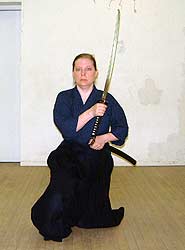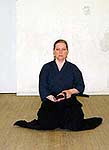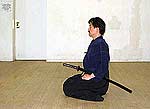Shohatto: The Heart Of Omori Ryu Iaido
By Deborah Klens-Bigman, Ph.D.
Editor's Note: This
article is part of a continuing series of articles on the Japanese
art of iaido, the modern discipline or
way of drawing
the sword that assumed its present form in the early 20th century.
Iaido was derived from iaijutsu, a sub-specialization of kenjutsu
(sword arts)
that was practiced by professional (samurai) warriors and involved
methods of drawing the sword and cutting as a single motion. This
article focuses
on the first of twelve kata known as Shohatto within the foundation
set (known as Shoden) of Muso Shinden ryu iaido (meaning, “transmission
[of] divine vision”), the style of sword drawing that the author
teaches. In iaido and many classical sword arts kata(prearranged
sequences of movement) are used as the primary tool to teach and
transmit the
art. For more information on Muso Shinden Ryu iaido see:Omori
Ryu: The Foundation of Muso Shinden Ryu Iaido.
For other articles on iaido by this author visit the Reading Room
under the heading “Iaido.”
Historic Background
 As discussed previously in my series of articles on iaido (the Japanese
art of drawing the sword), the Omori ryu kata of the Muso Shinden ryu
are the shoden (beginning curriculum) of the Omori ryu style of iaido.
Shohatto is the first form in the Omori set. Though we can straightforwardly
translate the word “shohatto” to mean “rules,” its
meaning goes deeper than that. The Shohatto kata contains the basic elements
of Omori ryu, and, more broadly, of swordsmanship in general. By learning
the “rules” of Shohatto, one learns the rules of the art.
Drawing, two types of cut (single-handed and two-handed) resheathing,
and etiquette are contained here. My teacher, Otani Yoshiteru, says you
can learn the principles of sword technique from Shohatto. If you learn
the principles, “style does not matter.” In other words,
the principle is the same regardless of technique. Learn the principles,
and the technique comes naturally. As discussed previously in my series of articles on iaido (the Japanese
art of drawing the sword), the Omori ryu kata of the Muso Shinden ryu
are the shoden (beginning curriculum) of the Omori ryu style of iaido.
Shohatto is the first form in the Omori set. Though we can straightforwardly
translate the word “shohatto” to mean “rules,” its
meaning goes deeper than that. The Shohatto kata contains the basic elements
of Omori ryu, and, more broadly, of swordsmanship in general. By learning
the “rules” of Shohatto, one learns the rules of the art.
Drawing, two types of cut (single-handed and two-handed) resheathing,
and etiquette are contained here. My teacher, Otani Yoshiteru, says you
can learn the principles of sword technique from Shohatto. If you learn
the principles, “style does not matter.” In other words,
the principle is the same regardless of technique. Learn the principles,
and the technique comes naturally.
At New York Budokai, Shohatto is the first form (kata) the beginner
learns, and the one he or she must perform for every dan test (the term
dan indicates rank, or black belt level above lower kyu levels of achievement
used for beginner grades), regardless of what other kata must be performed.
In this essay we will consider the importance of this kata in depth.
In the first place, I should point out that unlike some kata in other
martial art styles, iaido kata are brief. All iaido kata begin and end
with the sword in its saya (sheath). In between an imaginary opponent
(or opponents) is quickly dispatched. There are several reasons for the
brevity of iaido kata: for one, to mercilessly cut up an opponent when
one could simply dispatch him is unpleasant, to say the least, not to
mention dishonorable. Second, the bunkai (applications) of iaido kata
is all based in reality. As historical accounts show, a sword fight,
once someone initiates one, is over very quickly, almost before spectators
realize what has happened. One (or more) person falls, the other (hopefully)
walks away. End of story.
Early 20th Century observer E.J. Harrison recorded the reminiscences
of a judo teacher named Yokoyama who witnessed a fight between a ronin
(masterless samurai) and three younger opponents:
The ronin...advanced
steadily with the point of his weapon directed against the samurai
in the center of the trio...the samurai in the middle
gave way [as he advanced]...The right-hand samurai...rushed to the
attack, but the ronin...parried and with lightning rapidity cut his enemy
down...The
left-hand samurai...was treated in similar fashion, a single stroke
felling him...The samurai in the center, seeing the fate of his comrades...took
to his heels. (Ratti and Westbrook 1973, 123-124)
Though not a first-hand account, the story illustrates the speed with
which a duel could take place.
To lengthen sword kata so the trainee has more to do, therefore, contradicts
the spirit of the art form, and it’s useless in terms of learning
technique, since a confrontation would not happen that way in all likelihood.
In spite of its meditative qualities, there should always be credibility
in iaido technique. Though this can be seen as a contradiction (learning
the proper way to kill someone as a means to meditate on life and death),
I assure you it’s not. Without the proper technique, how can your
meditation be any good? Or, put another way, if your technique lacks
integrity, so will your meditation.
The bunkai (application) of Shohatto is fairly straightforward. The
iaidoka (the iaido practitioner) sits in seiza (kneeling position), hands
at rest. An opponent across from him makes a hostile move, i.e. brings
his hands to his sword in preparation for a draw. The iaidoka reacts
by drawing as he rises to his knees, steps forward and cuts across the
opponent’s face. Depending on the draw, this cut could be aimed
anywhere from the opponent’s eyes to his neck. The iaidoka may
or may not connect with this cut; but in any case, the attacker refuses
to back down. The iaidoka follows up by moving closer to the opponent
and cutting straight down his center – a kirioroshi cut. This cut
extends from the top of the opponent’s head to his navel, and is
enough to disable or kill him. The iaidoka then ends by cleaning the
blood from his sword, stands up to better view what has happened, and
returns the sword to its scabbard.
Click the photos below to see the sequences
(Flash Player required)
(Front View)

Use this
link if you don't have Flash
(Opens in new window)
(Side View)

Use this
link if you don't have Flash
(Opens in new window)
As can be seen from the photo sequence, the first movement, once a threat
is sensed, is for the iaidoka to bring both hands to the sword. The left
hand takes the saya (sword scabbard) and the right takes hold of the
tsuka (grip). At the same time, the iaidoka tucks his toes under him
as he begins to rise to his knees. By the time he is on his knees, the
sword is more than halfway out. The iaidoka draws the sword toward his
opponent with his right hand, while the left hand pulls the saya around
his body to the back (sayabiki). The shoulders stay relaxed and squared
to the opponent. The iaidoka's weight remains centered - he does not
lean toward his opponent. As the cut is completed, the iaidoka positions
his right foot, knee raised.
As he repositions his sword in jodan (high position) for the next cut,
the iaidoka pulls himself forward, repositioning the right foot as he
makes the final cut. The iaidoka then stands as he begins o-chiburi (a
small fast action designed to splash off blood from the blade), switches
the position of his feet (perhaps the better to see his fallen opponent)
and sheathes the sword.
Shohatto practice begins the process of concentration and focus that
leads to good meditative practice. While one hears about the meditative
aspects of martial arts practice not much is said about how to get to
the meditative state. The bunkai (application) of the Shohatto kata aids
focus and leads to concentration, one of the prerequisites of good meditative
practice. As the practitioner learns to focus and concentrate on the
hypothetical situation at hand, distractions fall away. As the distractions
dissipate, there is room for meditative contemplation to take place.
This process takes many years of practice, but it is the heart of iaido
for the long-time practitioner.
Shohatto practice enables the iaidoka to build skill, strength and flexibility
needed to pursue the rest of Omori ryu (the other eleven kata and technique
in the beginning curriculum) and the balance of Muso Shinden ryu iaido
kata. Beginning kata from seiza (kneeling position) not only trains one
in the most basic of postures, but the position is also an important
physical aspect of traditional Japanese culture. Combined with reishiki
(the way to bow), the Shohatto kata teaches not only the rudiments of
Muso Shinden Ryu Iaido technique, it teaches etiquette and acquaints
the beginner with the traditional arts of which iaido is a part. Rising
from seiza strengthens the quadriceps, hips and lower back. Proper drawing,
cutting and sheathing of the sword are therefore taught from a relatively
slow and stable position and complex set of movements. The slow, formalistic
pace of Shohatto benefits the beginner and aids the teacher in imparting
technique.
A less direct benefit of Shohatto practice is that it introduces the
beginner to the complexity of iaido practice, and the patience needed
to engage in it. As such, Shohatto practice is useful in “weeding
out” potential students whose temperment may not be suited to the
sustained practice of iaido. Many Westerners (as well as modern Japanese)
find sitting in seiza to be uncomfortable at the beginning. Sayabiki
(pulling the scabbard with the left hand to bring it around your behind
left hip, a movement used to facilitate the rapid drawing and cutting
movement with the sword) is a complex technique that can take years to
learn properly, let alone executing a proper cut. It takes perhaps six
months before the quadriceps can handle the slow, sustained movement.
The lower back and hips must work to keep the body straight. Determination
to learn the first Shohatto kata (or not) reveals the student’s
intention perhaps before he is even aware of it himself. The student
who complains about Shohatto is a poor candidate to learn the rest of
the Muso Shinden ryu kata. On the other hand, it is very moving to watch
a determined student overcome whatever physical limitations she may have
as she strives to perfect the form.
Shohatto has many levels of meaning for the iaidoka. On a basic level,
it is a patterned response to a hypothetical attack. As the first kata
taught, it acquaints the beginner with basic technique; for the experienced
practitioner, it is a way of returning to the sense of "beginner's
mind" whenever it is performed. The advantages of that mindset though
often alluded to, are rarely spelled out: courage, humility, patience
and contemplation.
About the Author:
Deborah Klens-Bigman is Manager and Associate Instructor of iaido at
New York Budokai in New York City. She has also studied, to varying extents,
kendo, jodo (short staff), kyudo (archery) and naginata (halberd). She
received her Ph.D in 1995 from New York University's Department of Performance
Studies where she wrote her dissertation on Japanese classical dance
(Nihon Buyo). and she continues to study Nihon Buyo with Fujima Nishiki
at the Ichifuji-kai Dance Association. Her article on the application
of performance theory to Japanese martial arts appeared in the Journal
of Asian Martial Arts in the summer of 1999. She is married to artist
Vernon Bigman. For FightingArts.com she is Associate Editor for Japanese
Culture/Sword Arts.
|